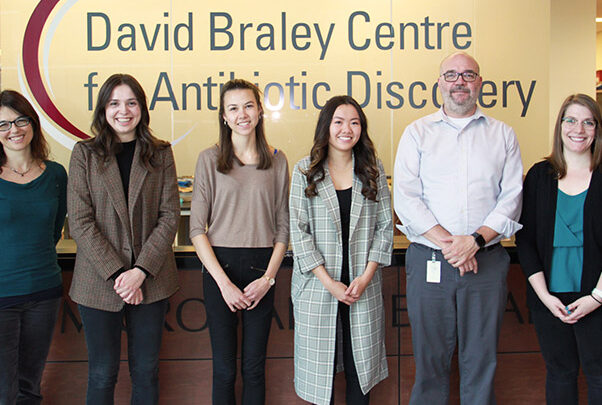Program Overview
Trainees will gain a fulsome understanding of the complexity and challenges of diagnosing and managing AMR through a tailored educational experience using a case-study and problem-based learning approach.
The program consists of two components. Between October and April, fellows will participate in a course consisting of lectures and discussions facilitated by special guest speakers. Guests come to us with expertise in the many facets of AMR, including public health, industry, and more. This component also includes a visit the Public Health Ontario laboratory in Toronto to gain a better understanding of how AMR is detected and tracked at a provincial level. Braley Fellows may take this course either as an elective course or an extra course, upon permission of the course instructor and their graduate program. The second component is a research project that will be performed in collaboration with a partner that may include a clinician, a scientist from Public Health Ontario, or an otherwise relevant community partner. This is expected to occur in the Summer term and to include 133 hours of work.
Eligibility
PhD students supervised by an IIDR faculty member entering their 3rd or 4th year of their program. Students must have the approval of their supervisor.
Students must have a demonstrated record of research productivity (e.g. manuscripts published or submitted) and their supervisor must email the Braley Fellows lead, indicating that participation in the project will not interfere with the student’s research and that they understand they will be performing a research project in lieu of a TA position.
Students must agree to forgoing their TA position for the time they are in the Braley Fellows program and will receive an equivalent stipend to perform a research project equivalent to a 133 hr TA.
This program is designed to be accessible to all members of the IIDR and does not require the applicant to be studying AMR as part of their PhD research. Applicants from all graduate programs are encouraged to apply.
Learning Objectives
Based on conversations with experts in the field, the following learning objectives were outlined to investigate throughout the duration of the program:
1. Diagnosis and detection: how the diagnosis of pathogens and AMR occurs. Objectives include understanding:
- how technologies for detecting infections and AMR work
- the need for rapid diagnosis to inform clinical decision-making
- which infections are reported to public health agencies and why
2. Antibiotic use in the clinic: how antibiotics are prescribed in the clinic. Objectives include understanding:
- empirical antibiotic use strategies
- the evidence of how clinical breakpoints are determined
3. Diagnosis as prognosis: how diagnosis with an antibiotic resistant infection impacts clinical decision-making and alters patient prognosis. Objectives include:
- Understanding how AMR is diagnosed in clinical microbiology labs
- Investigating the evidence supporting how specific determinants of resistance influence clinical decision making and patient prognosis
4. Tracking AMR at the population level: how public health agencies track antimicrobial resistance. Objectives include understanding:
- how AMR is identified in public health labs and how this information is disseminated and used to inform policy decisions
- how epidemiology databases are used for disease surveillance and to calculate the costs of AMR
5. Antimicrobial stewardship and clinical AMR management. Objectives include understanding:
- how antimicrobial stewardship strategies are developed at the institutional level
- how AMR is managed at the patient level
- differences in management strategies based on specific resistance genes
- how vaccination can be used to combat AMR
- formulary considerations: what drugs are used in what order and why? What do hospitals purchase and in what volumes?
6. From evidence to impact: How WHO guidelines for antibiotic use are developed and implemented. Objectives include understanding:
- what is included in a policy guideline and how decision makers are selected
- how guidelines are developed using XDR-MTB as a case study
- the obstacles to implementation of WHO AMR guidelines


